Many of us in the donor-conceived (DC) community have already seen the series as the Australian show Sisters on Netflix. I hope the new incarnation changes the ending, which was the worst since the supposedly-dead Bobby Ewing appeared in the shower in the 1986 finale of the TV series Dallas and revealed that the entire season, in which he’d died, had been a dream.

The 2013 film Delivery Man preceded both versions of Dr. Bechley’s misadventures. In it, Vince Vaughan is the befuddled father of 533 twenty-somethings, thanks to long-ago sperm donations. A lot of them.
The danger of unintentional inbreeding
We hardly need fictional accounts of surprise insta-families. The situation is very real, thanks to a convergence of factors: poor regulation of assisted reproductive technologies over decades, the past prioritization of sperm donor privacy over offsprings’ right-to-know, and the rise of consumer DNA testing that probably no donors, and not even their doctors, ever imagined.
And so the media continues to spit out the stories, still with a tone of awe:
- “A growing family,” from the Associated Press, recently covered 31-year-old Morgan Richardson’s discovery of 15 half-siblings.
- The New York Times Magazine cover from June 30, 2019, displayed all 32 half-siblings of Eli Baden-Lasar, to accompany his photo essay “Brothers, Sisters, Strangers.”
- A class action lawsuit in Indianpolis is targeting a doctor who too widely spread his seed.
Well-meaning friends who know I’ve discovered six half-siblings over the past year send me these articles. I wish they wouldn’t. Not because they upset me anymore, but because the overactive sperm donor stories that make it to the media are a tiny tip of a non-melting, actually explosively growing, iceberg.
Judging from the half dozen private Facebook groups I’m in, and perusing the Donor Sibling Registry, it’s clear that we number in the tens of thousands, and perhaps an order of magnitude more.
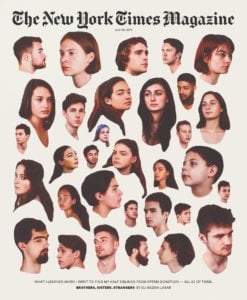 The problem isn’t with sperm donation itself, which is after all a way to circumvent infertility, but with using sperm from a single man for too many recipients, because the anonymity introduces the possibility of dating one’s half sibling. And that could spawn inadvertent consanguinity (“shared blood”). Unintentional inbreeding.
The problem isn’t with sperm donation itself, which is after all a way to circumvent infertility, but with using sperm from a single man for too many recipients, because the anonymity introduces the possibility of dating one’s half sibling. And that could spawn inadvertent consanguinity (“shared blood”). Unintentional inbreeding.
When two people share a disease-causing recessive mutation inherited from a shared ancestor, like a great-grandparent, each of their potential kids has a 25% risk of inheriting the associated disease. It’s Mendel’s first law in action.
The anonymity of sperm donations robs the descendants of recipients of the choice not to have children with their blood relatives. A way to methodically avoid consanguinity is described in The Testaments, the sequel to Margaret Atwood’s classic 1998 novel The Handmaid’s Tale.
Gilead’s solution: good record-keeping
Gilead is centered in what was once Boston, with tentacles reaching up and down the east coast. People are assigned to rigidly defined classes by roles and occupations, and a few men rule to a horrific degree. With rampant infertility due to pollution, fertile young women serve as Handmaids to maintain the population.
Handmaids are forced into a red-draped, white-bonneted sameness and assigned to Commanders whose Wives (official castes are capped) haven’t conceived, and then are ritually raped during their fertile periods. The Wives watch and assist the sanctioned serial sexual assaults, then steal, own and raise the resulting children.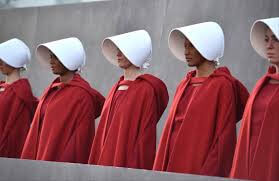
Sometimes Handmaids sneak off to become pregnant by someone else, such as a lowly male employee of the household, because if she doesn’t conceive within a year or so, she’s blamed, reassigned, and if that fails too, killed and hung on the Wall like others who disobey the law.
Because in Gilead the mommy isn’t the mommy and the daddy sometimes isn’t the daddy, someone has to track the genetics to avoid consanguinity.
The task of recording and maintaining the true genealogies, inscribed in volumes of the Bloodline Genealogical Archives in a locked room in a heavily guarded mausoleum-like building, falls to the Aunts, a select group of women who are allowed to read and think.
Explains Aunt Lydia:
It’s essential to record who is related to whom, both officially and in fact: due to the Handmaid system, a couple’s child may not be biologically related to the elite mother or even to the official father, for a desperate Handmaid is likely to seek impregnation however she may. It is our business to inform ourselves, since incest must be prevented: there are enough Unbabies already.
Unbabies are the unfortunate consequence of those recessive genes matching up, as well as other birth defects arising from the wrecked environment.
A particular concern is that the Commanders, generally older men, go through many Wives and beget many children. They find crude ways to bring early demise to the Wives, such as poisoning, frequently replacing them with younger models (Atwood claims never to write a scene that doesn’t actually happen).
A fresh, new Wife could, biologically speaking, be a Commander’s daughter. Or even a granddaughter.
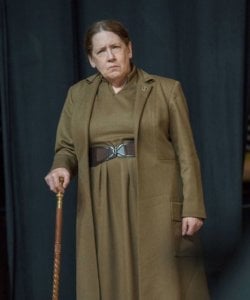
“With so many older men marrying such young girls, Gilead could not risk the dangerous and sinful father-daughter inbreeding that might result if no one was keeping track,” Lydia writes in her journal, which forms one of three narrative threads of The Testaments, read from a distant future.
Inspiration from a religious community
Atwood’s Bloodline Genealogical Archives of Gilead may have borrowed from the “confidential premarital testing system” Dor Yeshorim (Hebrew for “upright generation”). The program screens potential partners for mutations in the same recessive genes responsible for diseases that are more prevalent in the Jewish population.
Holocaust survivor and rabbi Josef Ekstein began Dor Yeshorim in Brooklyn in 1983, following the birth of his third child to have inherited the devastating Tay-Sachs disease from the two carrier parents. Today, the organization has an international reach. The process identifies people by numbers, and carriers aren’t told what they carry, just with whom they shouldn’t procreate.
By 2010, more than 300,000 young people worldwide had taken carrier tests for an ever-expanding list of diseases through Dor Yeshorim, and more than 20,000 individuals are screened each year. Similar programs operate throughout the world. Call it eugenics or artificial selection, but Dor Yeshorim has practically vanquished certain devastating diseases.
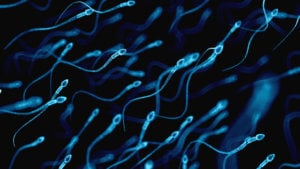
A brief history of sperm donation
The Handmaids of Gilead knew when sex was being forced upon them. Everyone knew. But in a sickening example of truth being stranger than fiction, women who were artificially inseminated decades ago in the US to help them conceive sometimes didn’t know what was happening to them. Dani Shapiro details the practice in her book Inheritance: A Memoir of Genealogy, Paternity, and Love.
Which one is the dystopia?
In 1909, physician Addison Davis Hard published a letter in The Medical World detailing the insemination of a woman with “carefully selected seed.” He and six other medical students witnessed the event at Sansom Street hospital of Jefferson Medical College in Philadelphia in 1884 and were pledged to keep secret the “artificial impregnation.” The husband made no sperm.
Dr. Hard wrote:
The woman was chloroformed, and with a hard rubber syringe some fresh semen from the best-looking member of the class was deposited in the uterus, and the cervix slightly plugged with gauze. Neither the man nor the woman knew the nature of what had been done at the time, but subsequently the Professor repented of his action, and explained the whole matter to the husband.
The oblivious woman gave birth to a healthy boy, who grew up to become a businessman whom the good Dr. Hard reported having met.
The 1909 paper ends with the peculiar admonition that “the mother is the complete builder of the child,” and lists how her parts are echoed in the child. But this was just nine years after the rediscovery of Mendel’s work, a scientific achievement not nearly as celebrated as that of his contemporary, Charles Darwin. And it’s unlikely that the medical school professor performing the insemination in 1884 had read Mendel’s paper on peas, published in 1865.

I can even understand why physicians in 1953, when I was conceived, might not have considered the fact that each parent contributes half of the genetic material. Watson and Crick’s paper was published in April of that year and I apparently became an “artificially inseminated product” two months before that. I had no idea that I was and don’t even know if my mother knew.
But what was the excuse for ignorance of genetics in 1979?
That year, a seminal article in The New England Journal of Medicine reported a survey of 379 doctors who’d performed artificial insemination by donor in 1977, yielding 3,576 births. Some men indicated that they’d made multiple donations, the winner a man whose sperm impregnated 50 women. And the recipients tended to live in the same communities.
That study inspired the opening of the first sperm bank. Didn’t any medical professional think about what might happen if unknowing half-siblings married? A talk show host did.
I remember an episode of the Phil Donohue show from the 1980s featuring a few couples, from Chicago, who’d somehow found out they were half-siblings, long before spit-in-the-tube consumer DNA testing. They’d all partook of product from the Repository for Germinal Choice, a sperm bank in Escondido, California, that for a time collected, froze, and shipped deposits from Nobel Prizewinners.
Limiting sperm donations today
Although a quick perusal of sperm bank websites reveals that they nowadays try to limit availability of one man’s gametes to 25 to 30 women, the emphasis isn’t enough and the number is still unsettlingly high, because it doesn’t mirror normal human reproduction. Who normally has two dozen half siblings?
At the California Cryobank, the Policy of Offspring Limits states:
The maximum goal is 25-30 family units worldwide per donor. Each donor is limited by the length of time he remains active in the program. CCB also limits the total number of vials distributed and monitors pregnancy and birth reports to help maintain this goal.
The Cryos International Sperm & Egg Bank also limits distribution to 25, but will deliver sperm to a customer’s home! To share, all one needs is a turkey baster or similar inventive contraption.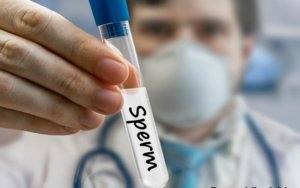
The equations of population genetics flit through my head. I fear that too many donor sperm from too few men could skew gene variant frequencies in directions that up the odds of an eventual increase in incidence of recessive diseases.
The American Society for Reproductive Medicine (ASRM) isn’t taking the matter seriously enough. They recently published a 7-page paper that includes just two paragraphs, at the end, on “Repeated Donations,” an apparent afterthought compared to the pages devoted to donor privacy rights. It is not-very-well disguised misogyny.
The attempt to prevent inadvertent incest is meek, at best. The document states:
As a condition for accepting the donor, it is permissible for a program to require donors to disclose the extent of their donation to other programs. The general practice of agencies, sperm banks, egg banks, and assisted reproductive technology programs is to limit the number of offspring per donor to avoid potential consanguinity issues in the offspring.
Good intentions, but donors can lie, especially when money is involved.
The lack of seriousness continues: “Limiting the number of donations also takes into account potential impact on both the offspring and the donor’s children of learning they may have multiple genetic relatives.”
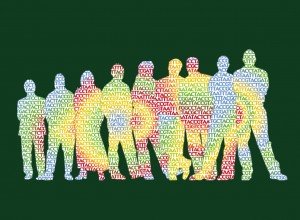 Is that all? The problem transcends simply “learning” of new relatives, to the shattering of one’s sense of identity and the immediate rewriting of health history.
Is that all? The problem transcends simply “learning” of new relatives, to the shattering of one’s sense of identity and the immediate rewriting of health history.
But I’m most concerned about the population genetics implications from a shrinking of the gene pool by skewing male reproductive contributions. Will we see, in a few generations, a return of the recessive diseases that carrier screening programs have controlled since the 1970s?
Limiting sperm donations to 25 women is not going to cut it in the long term.
It’s time for tighter regulation of assisted reproductive technologies, even if it requires record-keeping to rival that in Gilead.
Ricki Lewis is the GLP’s senior contributing writer focusing on gene therapy and gene editing. She has a PhD in genetics and is a genetic counselor, science writer and author of The Forever Fix: Gene Therapy and the Boy Who Saved It, the only popular book about gene therapy. BIO. Follow her at her website or Twitter @rickilewis
































